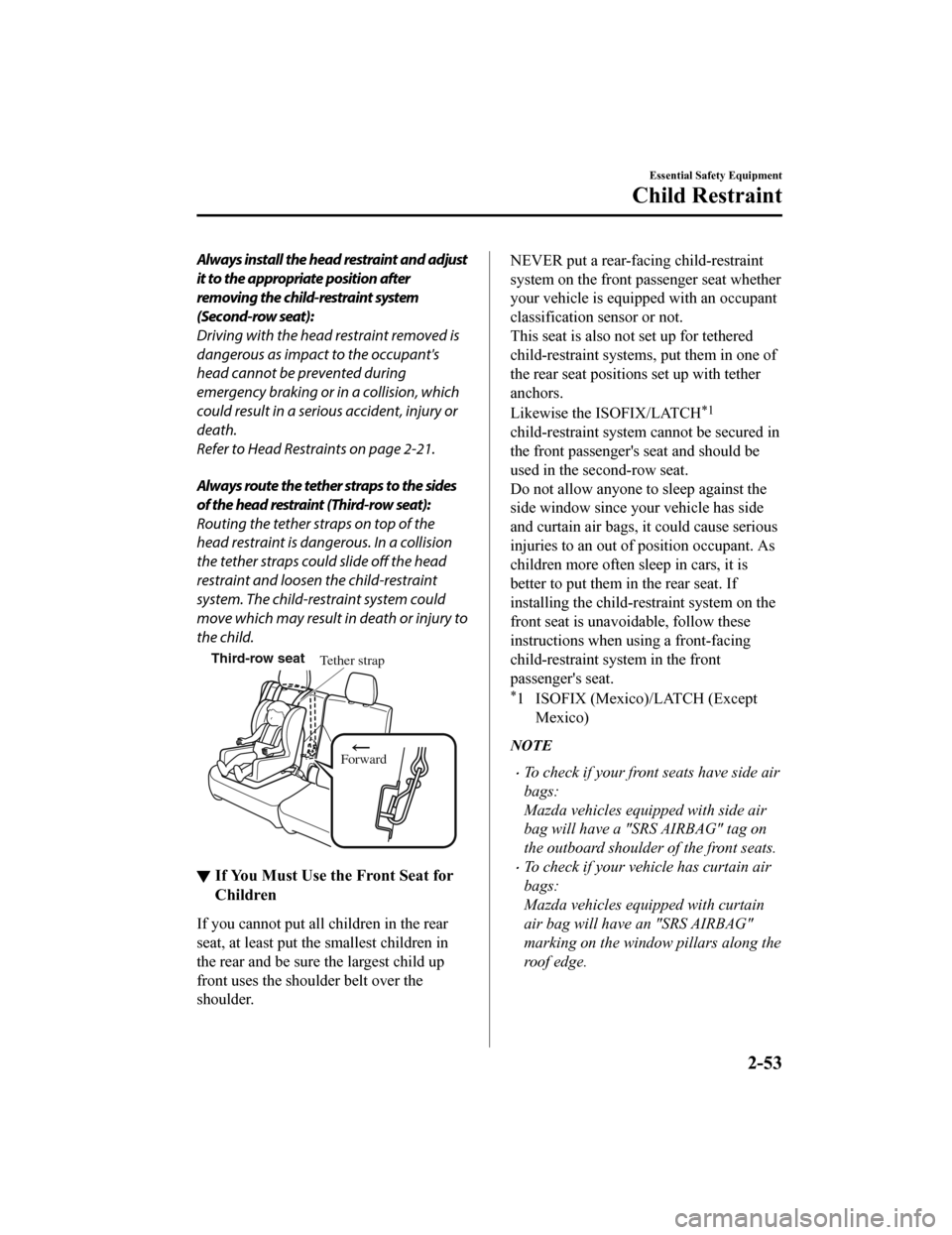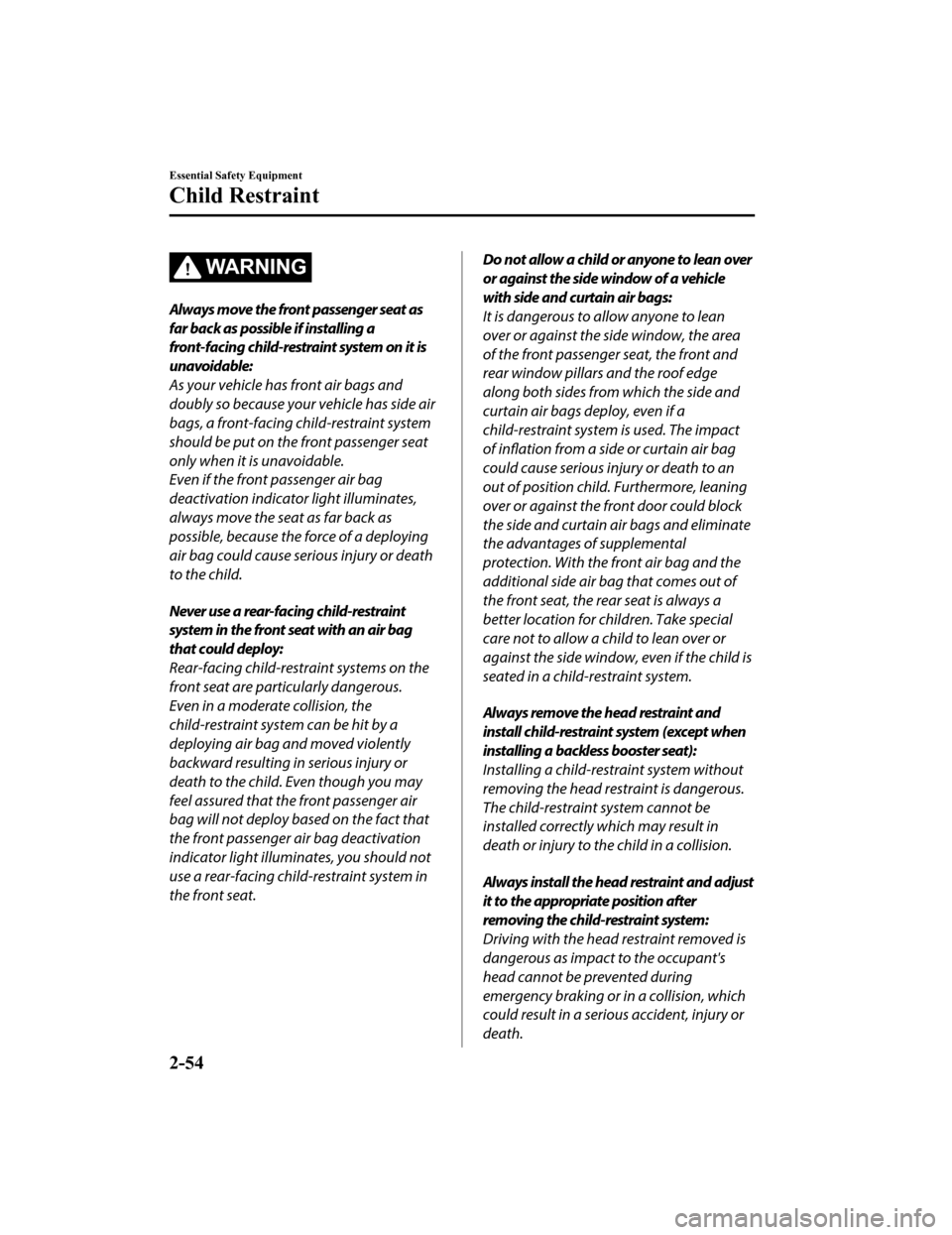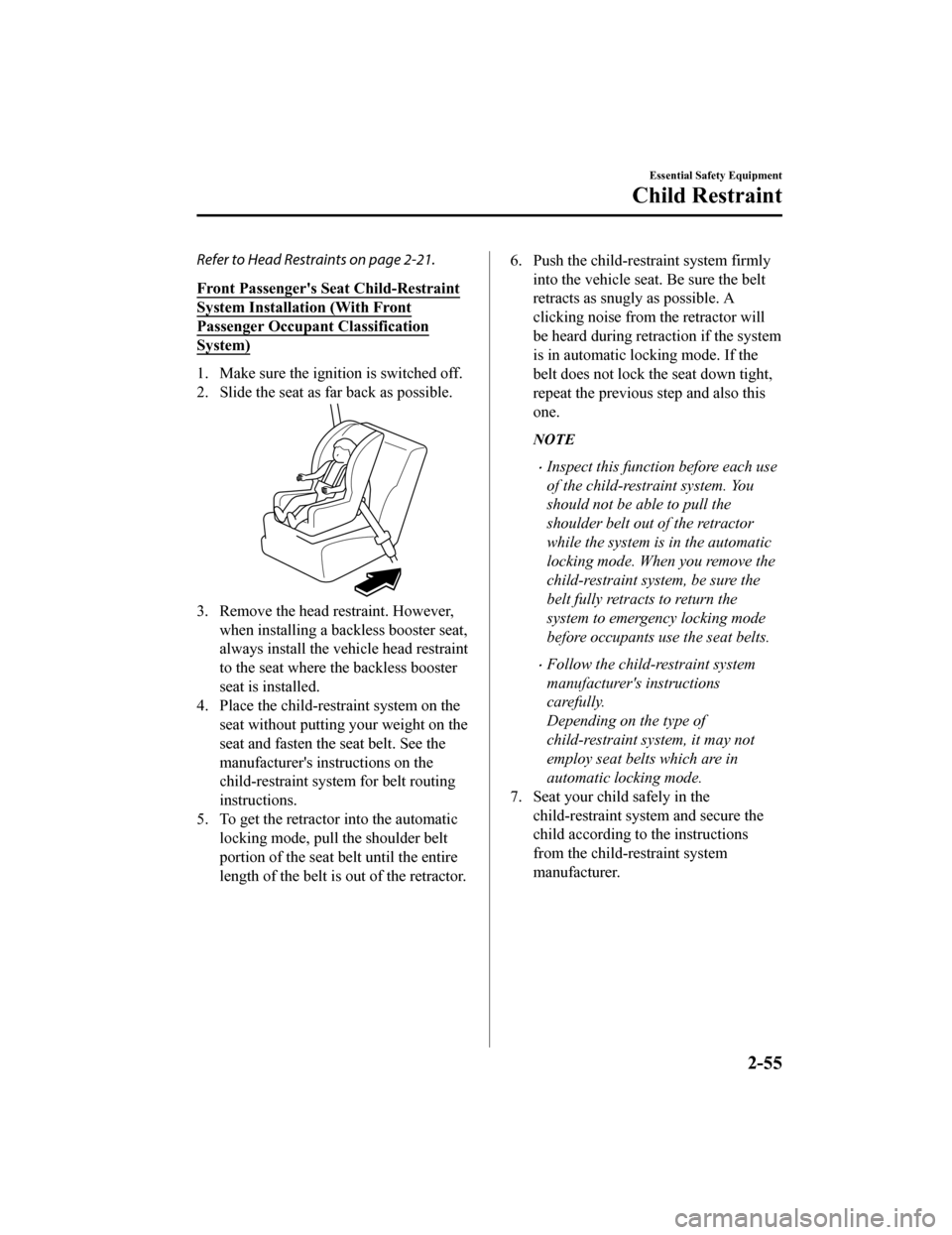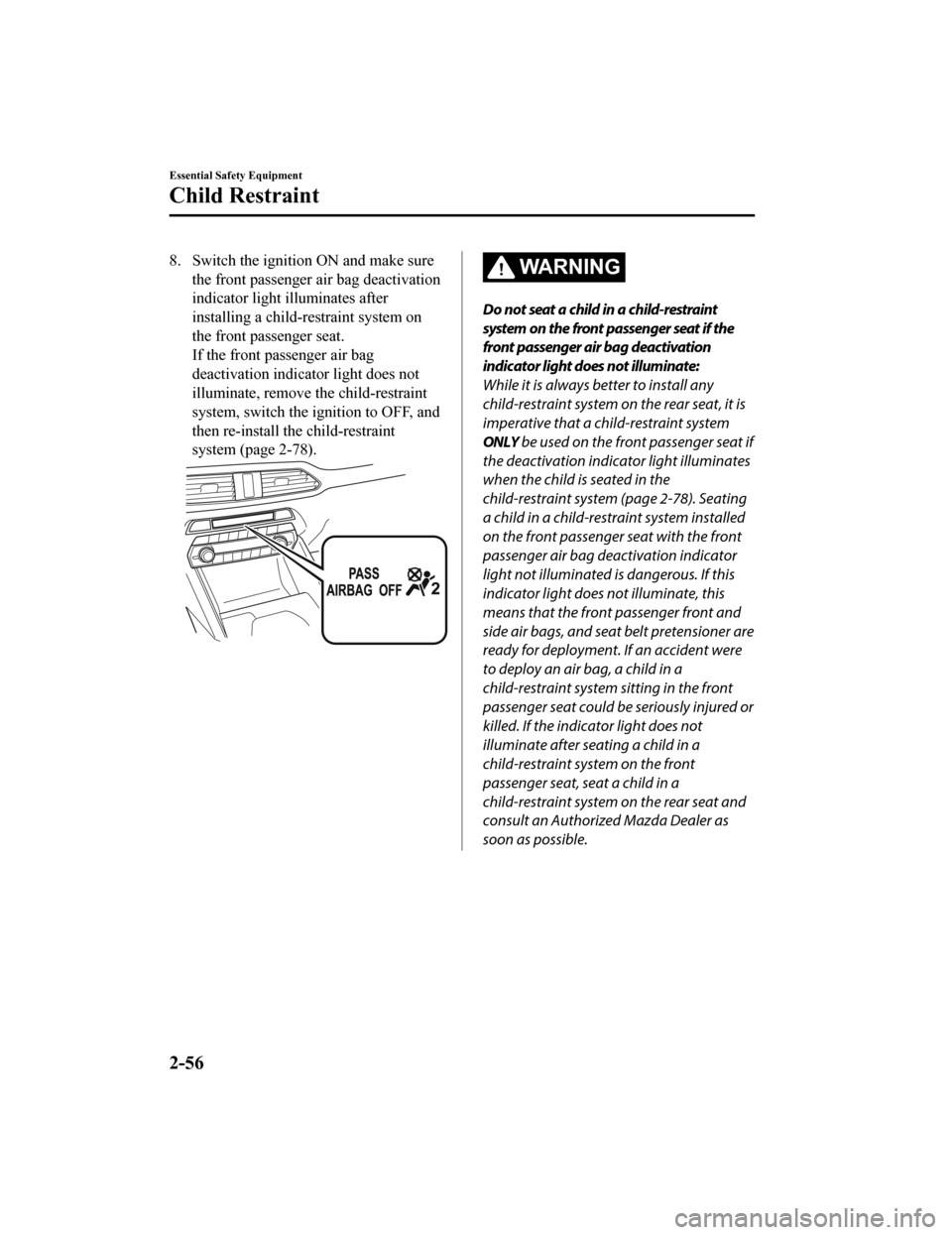MAZDA MODEL CX-9 2019 (in English) Repair Manual
Manufacturer: MAZDA, Model Year: 2019, Model line: MODEL CX-9, Model: MAZDA MODEL CX-9 2019Pages: 692
Page 61 of 692

Always follow the instruction manual
accompanying the child-restraint system.
Anchor bracket location
Use the indicated anchor bracket locations
when installing a child-restraint system
equipped with a tether.
For right
For center
For left
Second-row seat
* *
Except Mexico
Third-row seat
Some models.
WA R N I N G
Always attach the tether strap to the
correct tether anchor position:
Attaching the tether strap to the incorrect
tether anchor position is dangerous. In a
collision, the tether strap could come off
and loosen the child-restraint system. If the
child-restraint system moves it could result
in death or injury to the child.
Always remove the head restraint and
install child-restraint system (Second-row
seat):
Installing a child-restraint system without
removing the head restraint is dangerous.
The child-restraint system cannot be
installed correctly which may result in
death or injury to the child in a collision.
Tether strap
Forward
Second-row
outboard seat
Tether strap
Forward
Second-row
center seat
Always install the head restraint and adjust
it to the appropriate position after
removing the child-restraint system
(Second-row seat):
Driving with the head restraint removed is
dangerous as impact to the occupant's
head cannot be prevented during
emergency braking or in a collision, which
could result in a serious accident, injury or
death.
Refer to Head Restraints on page 2-21.
Essential Safety Equipment
Child Restraint
2-49
CX-9_8HB2-EA-18G_Edition1
2018-5-11 13:09:27
Page 62 of 692

Only use a tether anchor designed for the
second-row seats:
Using a third-row seat tether anchor on the
second-row seat is dangerous. The
child-restraint system cannot be installed
correctly which may result in death or
injury to the child in a collision.
Tether strap
Third-row seatSecond-row
outboard/center
Always route the tether straps to the sides
of the head restraint (Third-row seat):
Routing the tether straps on top of the
head restraint is dangerous. In a collision
the tether straps could slide
off the head
restraint and loosen the child-restraint
system. The child-restraint system could
move which may result in death or injury to
the child.
Tether strap
ForwardThird-row seat
▼Using Automatic Locking Mode
(Except Mexico)
Follow these instructions when using a
child-restraint system, unless you are
attaching a LATCH-equipped
child-restraint syst
em to the rear LATCH
lower anchors. Refer to “Using LATCH
Lower Anchor” (page 2-57).
NOTE
Follow the child- restraint system
manufacturer's instructions carefully. If
you are not sure whether you have a
LATCH system or tether, check in the
child-restraint system manufacturer's
instructions and follow them accordingly.
Depending on the type of child-restraint
system, it may use LATCH system instead
of seat belts or if the belt goes across the
child's chest, may recommend against
using automatic locking mode.
1. (Second-row seat)
Adjust the second-row seat position
using the following procedure.
Fold the second-row seatback
forward.
Raise the second-row seatback until
a click sound is heard and it is locked
in place.
2. If the second-row seat is reclined, return it to the upright position.
Essential Safety Equipment
Child Restraint
2-50
CX-9_8HB2-EA-18G_Edition1 2018-5-11 13:09:27
Page 63 of 692

3. Make sure the seatback is securelylatched by pushing it back until it is
fully locked.
4. (Second-row seat)
Remove the head restraint. However,
when installing a backless booster seat,
always install the vehicle head restraint
to the seat where the backless booster
seat is installed.
Refer to Head Restraints on page 2-21.
5. Secure the child-restraint system with
the lap portion of the lap/shoulder belt.
See the manufacturer's instructions on
the child-restraint system for belt
routing instructions.
6. To get the retractor into the automatic
locking mode, pull the shoulder belt
portion of the seat belt until the entire
length of the belt is out of the retractor.7. Push the child-restraint system firmlyinto the vehicle seat. Be sure the belt
retracts as snugly as possible. A
clicking noise from the retractor will
be heard during retraction if the system
is in the automatic locking mode. If the
belt does not lock the seat down tight,
repeat this step.
NOTE
Inspect this function before each use
of the child-restraint system. You
should not be able to pull the
shoulder belt out of the retractor
while the system is in the automatic
locking mode. When you remove the
child-restraint system, be sure the
belt fully retracts to return the
system to emergency locking mode
before occupants use the seat belts.
8. If your child-restraint system requires the use of a tether strap, refer to the
manufacturer's instructions to hook
and tighten the tether strap.
Essential Safety Equipment
Child Restraint
2-51
CX-9_8HB2-EA-18G_Edition1 2018-5-11 13:09:27
Page 64 of 692

WA R N I N G
Use the tether and tether anchor only for a
child-restraint system:
Using the tether or tether anchor to secure
anything but a child-restraint system is
dangerous. This could weaken or damage
the tether or tether anchor and result in
injury.
Always remove the head restraint and
install child-restraint system (except when
installing a backless booster seat)
(Second-row seat):
Installing a child-restraint system without
removing the head restraint is dangerous.
The child-restraint system cannot be
installed correctly which may result in
death or injury to the child in a collision.
Tether strap
Forward
Second-row
outboard seat
Tether strap
Forward
Second-row
center seat
Always attach the tether strap to the
correct tether anchor position:
Attaching the tether strap to the incorrect
tether anchor position is dangerous. In a
collision, the tether strap could come off
and loosen the child-restraint system. If the
child-restraint system moves it could result
in death or injury to the child.
Essential Safety Equipment
Child Restraint
2-52
CX-9_8HB2-EA-18G_Edition1
2018-5-11 13:09:27
Page 65 of 692

Always install the head restraint and adjust
it to the appropriate position after
removing the child-restraint system
(Second-row seat):
Driving with the head restraint removed is
dangerous as impact to the occupant's
head cannot be prevented during
emergency braking or in a collision, which
could result in a serious accident, injury or
death.
Refer to Head Restraints on page 2-21.
Always route the tether straps to the sides
of the head restraint (Third-row seat):
Routing the tether straps on top of the
head restraint is dangerous. In a collision
the tether straps could slide off the head
restraint and loosen the child-restraint
system. The child-restraint system could
move which may result in death or injury to
the child.
Tether strap
ForwardThird-row seat
▼If You Must Use th
e Front Seat for
Children
If you cannot put all children in the rear
seat, at least put the smallest children in
the rear and be sure the largest child up
front uses the shou lder belt over the
shoulder.
NEVER put a rear-facing child-restraint
system on the front passenger seat whether
your vehicle is equipped with an occupant
classification sensor or not.
This seat is also not set up for tethered
child-restraint system s, put them in one of
the rear seat positions set up with tether
anchors.
Likewise the ISOFIX/LATCH
*1
child-restraint system cannot be secured in
the front passenger's seat and should be
used in the second-row seat.
Do not allow anyone to sleep against the
side window since your vehicle has side
and curtain air bags, it could cause serious
injuries to an out of position occupant. As
children more often sleep in cars, it is
better to put them in the rear seat. If
installing the child-restraint system on the
front seat is unavoidable, follow these
instructions when using a front-facing
child-restraint system in the front
passenger's seat.
*1 ISOFIX (Mexico)/LATCH (Except Mexico)
NOTE
To check if your front seats have side air
bags:
Mazda vehicles equipped with side air
bag will have a "SRS AIRBAG" tag on
the outboard shoulder of the front seats.
To check if your vehicle has curtain air
bags:
Mazda vehicles equipped with curtain
air bag will have an "SRS AIRBAG"
marking on the window pillars along the
roof edge.
Essential Safety Equipment
Child Restraint
2-53
CX-9_8HB2-EA-18G_Edition1 2018-5-11 13:09:27
Page 66 of 692

WA R N I N G
Always move the front passenger seat as
far back as possible if installing a
front-facing child-restraint system on it is
unavoidable:
As your vehicle has front air bags and
doubly so because your vehicle has side air
bags, a front-facing child-restraint system
should be put on the front passenger seat
only when it is unavoidable.
Even if the front passenger air bag
deactivation indicator light illuminates,
always move the seat as far back as
possible, because the force of a deploying
air bag could cause serious injury or death
to the child.
Never use a rear-facing child-restraint
system in the front seat with an air bag
that could deploy:
Rear-facing child-restraint systems on the
front seat are particularly dangerous.
Even in a moderate collision, the
child-restraint system can be hit by a
deploying air bag and moved violently
backward resulting in serious injury or
death to the child. Even though you may
feel assured that the front passenger air
bag will not deploy based on the fact that
the front passenger air bag deactivation
indicator light illuminates, you should not
use a rear-facing child-restraint system in
the front seat.
Do not allow a child or anyone to lean over
or against the side window of a vehicle
with side and curtain air bags:
It is dangerous to allow anyone to lean
over or against the side window, the area
of the front passenger seat, the front and
rear window pillars and the roof edge
along both sides from which the side and
curtain air bags deploy, even if a
child-restraint system is used. The impact
of inflation from a side or curtain air bag
could cause serious injury or death to an
out of position child. Furthermore, leaning
over or against the front door could block
the side and curtain air bags and eliminate
the advantages of supplemental
protection. With the front air bag and the
additional side air bag that comes out of
the front seat, the rear seat is always a
better location for children. Take special
care not to allow a child to lean over or
against the side window, even if the child is
seated in a child-restraint system.
Always remove the head restraint and
install child-restraint system (except when
installing a backless booster seat):
Installing a child-restraint system without
removing the head restraint is dangerous.
The child-restraint system cannot be
installed correctly which may result in
death or injury to the child in a collision.
Always install the head restraint and adjust
it to the appropriate position after
removing the child-restraint system:
Driving with the head restraint removed is
dangerous as impact to the occupant's
head cannot be prevented during
emergency braking or in a collision, which
could result in a serious accident, injury or
death.
Essential Safety Equipment
Child Restraint
2-54
CX-9_8HB2-EA-18G_Edition12018-5-11 13:09:27
Page 67 of 692

Refer to Head Restraints on page 2-21.
Front Passenger's Seat Child-Restraint
System Installation (With Front
Passenger Occupant Classification
System)
1. Make sure the ignition is switched off.
2. Slide the seat as far back as possible.
3. Remove the head restraint. However,
when installing a backless booster seat,
always install the vehicle head restraint
to the seat where the backless booster
seat is installed.
4. Place the child-restraint system on the seat without putti ng your weight on the
seat and fasten the seat belt. See the
manufacturer's instructions on the
child-restraint system for belt routing
instructions.
5. To get the retractor into the automatic
locking mode, pull the shoulder belt
portion of the seat belt until the entire
length of the belt is out of the retractor.
6. Push the child-restraint system firmlyinto the vehicle seat. Be sure the belt
retracts as snugly as possible. A
clicking noise from the retractor will
be heard during retraction if the system
is in automatic lo cking mode. If the
belt does not lock the seat down tight,
repeat the previous step and also this
one.
NOTE
Inspect this function before each use
of the child-restraint system. You
should not be able to pull the
shoulder belt out of the retractor
while the system is in the automatic
locking mode. When you remove the
child-restraint system, be sure the
belt fully retracts to return the
system to emergency locking mode
before occupants use the seat belts.
Follow the child-restraint system
manufacturer's instructions
carefully.
Depending on the type of
child-restraint system, it may not
employ seat belts which are in
automatic locking mode.
7. Seat your child safely in the
child-restraint system and secure the
child according to the instructions
from the child-restraint system
manufacturer.
Essential Safety Equipment
Child Restraint
2-55
CX-9_8HB2-EA-18G_Edition1 2018-5-11 13:09:27
Page 68 of 692

8. Switch the ignition ON and make surethe front passenger air bag deactivation
indicator light illuminates after
installing a child-restraint system on
the front passenger seat.
If the front passenger air bag
deactivation indicator light does not
illuminate, remove the child-restraint
system, switch the i gnition to OFF, and
then re-install the child-restraint
system (page 2-78).WA R N I N G
Do not seat a child in a child-restraint
system on the front passenger seat if the
front passenger air bag deactivation
indicator light does not illuminate:
While it is always better to install any
child-restraint system on the rear seat, it is
imperative that a child-restraint system
ONLY be used on the front passenger seat if
the deactivation indicator light illuminates
when the child is seated in the
child-restraint system (page 2-78). Seating
a child in a child-restraint system installed
on the front passenger seat with the front
passenger air bag deactivation indicator
light not illuminated is dangerous. If this
indicator light does not illuminate, this
means that the front passenger front and
side air bags, and seat belt pretensioner are
ready for deployment. If an accident were
to deploy an air bag, a child in a
child-restraint system sitting in the front
passenger seat could be seriously injured or
killed. If the indicator light does not
illuminate after seating a child in a
child-restraint system on the front
passenger seat, seat a child in a
child-restraint system on the rear seat and
consult an Authorized Mazda Dealer as
soon as possible.
Essential Safety Equipment
Child Restraint
2-56
CX-9_8HB2-EA-18G_Edition1 2018-5-11 13:09:27
Page 69 of 692

▼(Mexico) Using ISOFIX Lower Anchor (Second-Row Seats)/(Except Mexico)
Using LATCH Lower Anch
or (Second-Row Seats)
Your Mazda is equipped with ISOFIX/LATCH*1 lower anchors for attachment of specially
designed ISOFIX/LATCH
*1 child-restraint systems in the second-row seats. Both anchors
must be used, otherwise the seat will bounce around and put the child in danger. Most
ISOFIX/LATCH
*1 child-restraint systems must a lso be used in conjunction with a tether to
be effective. If they have a teth er you must use it to better assure your child's safety.
WA R N I N G
Follow the manufacturer's instructions for the use of the child-restraint system:
An unsecured child-restraint system is dangerous . In a sudden stop or a collision it could move
causing serious injury or death to the child or other occupants. Make sure the child-restraint
system is properly secured in place accordin g to the child-restraint system manufacturer's
instructions.
Never attach two child-restraint systems to the same ISOFIX/LATCH
*1 lower anchor:
Attaching two child-restraint systems to the same ISOFIX/LATCH
*1 lower anchor is dangerous.
In a collision, one anchor may not be strong enough to hold two child-restraint system
attachments, and it may break, causing serious inju ry or death. If you use the seat position for
another child-restraint system when an outboard ISOFIX/LATCH
*1 position is occupied, use
the center seat belts instead, and the tether if tether-equipped.
Make sure the child-restraint system is properly secured:
An unsecured child-restraint system is dangerous . In a sudden stop or a collision it could move
causing serious injury or death to the child or other occupants. Follow the child-restraint
system manufacturer's instructions on belt routin g to secure the seat just as you would with a
child in it so that nobody is tempted to put a child in an improperly secured seat later on.
When not in use, remove it from the vehicle or fasten it with a seat belt, or attach it to BOTH
ISOFIX/LATCH
*1 lower anchors for ISOFIX/LATCH*1 child-restraint systems.
Essential Safety Equipment
Child Restraint
2-57
CX-9_8HB2-EA-18G_Edition1 2018-5-11 13:09:27
Page 70 of 692

Make sure there are no seat belts or foreign objects near or around the ISOFIX/LATCH*1
child-restraint system:
Not following the child-restraint system manufacturer's instructions when installing the
child-restraint system is dangerous. If seat belts or a foreign object prevent the child-restraint
system from being securely attached to the ISOFIX/LATCH
*1 lower anchors and the
child-restraint system is installed improperly, the child-restraint system could move in a
sudden stop or collision causing serious injury or death to the child or other occupants. When
installing the child-restraint system, make sure there are no seat belts or foreign objects near
or around the ISOFIX/LATCH
*1 lower anchors. Always follow the child-restraint system
manufacturer's instructions.
*1 ISOFIX (Mexico)/LATCH (Except Mexico)
Installation on second-row outboard
seats
1. First, adjust the front seat to allow clearance between the child-restraint
system and the front seat.
Refer to Adjusting the Driver's Seat on
page 2-5.
Refer to Adjusting the Front
Passenger's Seat on page 2-13.
2. Adjust the second-row seat position using the following procedure.
Fold the second-row seatback
forward.
Raise the second-row seatback until
a click sound is heard and it is locked
in place.
3. If the second-row seat is reclined, return it to the u pright position.
4. Make sure the seatback is securely
latched by pushing it back until it is
fully locked.
5. Expand the area between the seat
bottom and the seatback slightly to
verify the locatio ns of the ISOFIX/
LATCH
*1 lower anchors.
NOTE
The markings above the ISOFIX/
LATCH
*1 lower anchors indicate the
locations of the ISOFIX/LATCH
*1
lower anchors for the attachment of
a child-restraint system.
Essential Safety Equipment
Child Restraint
2-58
CX-9_8HB2-EA-18G_Edition1 2018-5-11 13:09:27